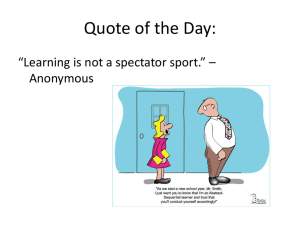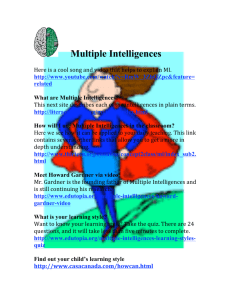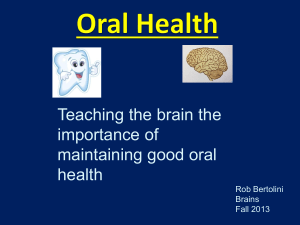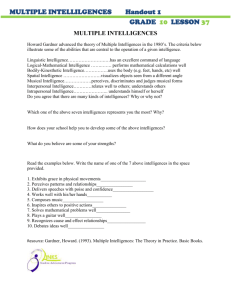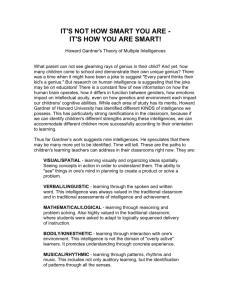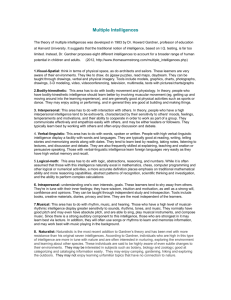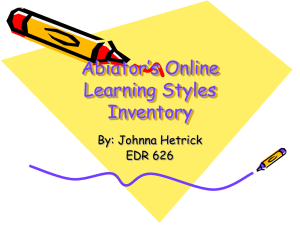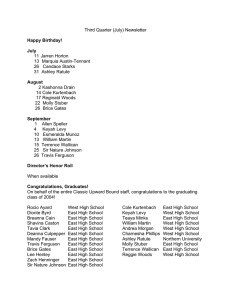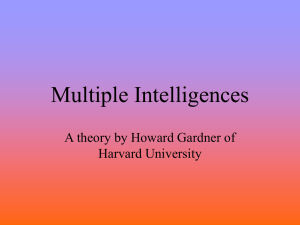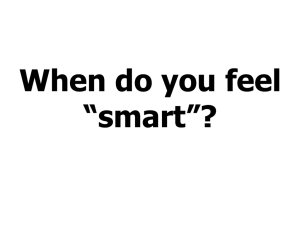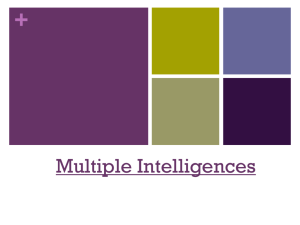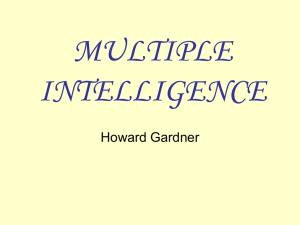IT'S NOT HOW SMART YOU ARE -
advertisement
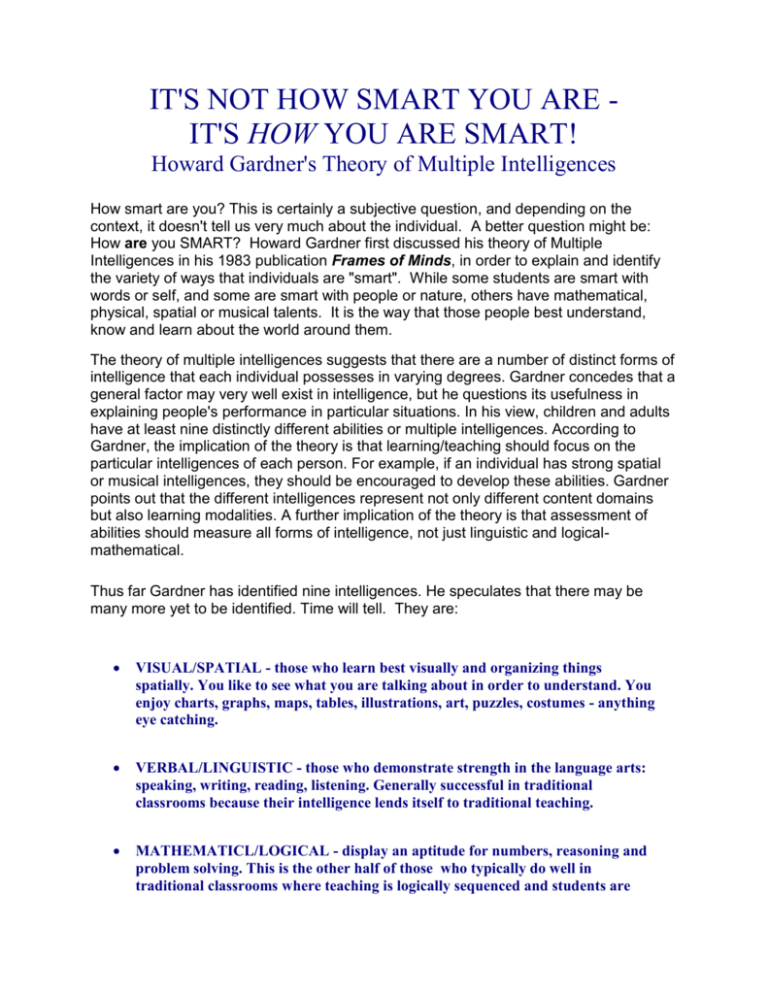
IT'S NOT HOW SMART YOU ARE IT'S HOW YOU ARE SMART! Howard Gardner's Theory of Multiple Intelligences How smart are you? This is certainly a subjective question, and depending on the context, it doesn't tell us very much about the individual. A better question might be: How are you SMART? Howard Gardner first discussed his theory of Multiple Intelligences in his 1983 publication Frames of Minds, in order to explain and identify the variety of ways that individuals are "smart". While some students are smart with words or self, and some are smart with people or nature, others have mathematical, physical, spatial or musical talents. It is the way that those people best understand, know and learn about the world around them. The theory of multiple intelligences suggests that there are a number of distinct forms of intelligence that each individual possesses in varying degrees. Gardner concedes that a general factor may very well exist in intelligence, but he questions its usefulness in explaining people's performance in particular situations. In his view, children and adults have at least nine distinctly different abilities or multiple intelligences. According to Gardner, the implication of the theory is that learning/teaching should focus on the particular intelligences of each person. For example, if an individual has strong spatial or musical intelligences, they should be encouraged to develop these abilities. Gardner points out that the different intelligences represent not only different content domains but also learning modalities. A further implication of the theory is that assessment of abilities should measure all forms of intelligence, not just linguistic and logicalmathematical. Thus far Gardner has identified nine intelligences. He speculates that there may be many more yet to be identified. Time will tell. They are: VISUAL/SPATIAL - those who learn best visually and organizing things spatially. You like to see what you are talking about in order to understand. You enjoy charts, graphs, maps, tables, illustrations, art, puzzles, costumes - anything eye catching. VERBAL/LINGUISTIC - those who demonstrate strength in the language arts: speaking, writing, reading, listening. Generally successful in traditional classrooms because their intelligence lends itself to traditional teaching. MATHEMATICL/LOGICAL - display an aptitude for numbers, reasoning and problem solving. This is the other half of those who typically do well in traditional classrooms where teaching is logically sequenced and students are asked to conform. BODILY/KINESTHETIC - experience learning best through activity: games, movement, hands-on tasks, building. Often labelled "overly active" in traditional classrooms where they were told to sit and be still! MUSICAL/RHYTHMIC - learn well through songs, patterns, rhythms, instruments and musical expression. INTRAPERSONAL - especially in touch with their own feelings, values and ideas. Tend to be more reserved, but they are actually quite intuitive about what they learn and how it relates to themselves. INTERPERSONAL - noticeably people oriented and outgoing, and do their learning cooperatively in groups or with a partner. May have typically been identified as "talkative" or " too concerned about being social" in a traditional setting. NATURALIST - love the outdoors, animals, field trips. More than this, though, they love to pick up on subtle differences in meanings. EXISTENTIALIST - learn in the context of where humankind stands in the "big picture" of existence. They ask "Why are we here?" and "What is our role in the world?" This intelligence is seen in the disciplines of philosophy and theology. http://www.interserf.net/mcken/mi.htm The chart below may help you to understand the variations in how these multiple intelligences may affect our thinking and learning: Intelligence THINK LOVE Verballinguistic In words Reading, writing, telling stories, playing word games, etc. Logicalmathematics By reasoning Visual-spatial In images and pictures; seeing BodilyKinesthetic Through somatic sensations Musicalrhythmic Via rhythms and melodies; movement Interpersonal By bouncing ideas off other people Intrapersonal Deeply inside of themselves Naturalist About natureplants, animals and naturally occurring patterns Existentialist About meaning and human existence NEED Books, tapes, writing tools, paper, diaries, dialogue, discussion, debate, stories, etc. Experimenting, questioning, Things to explore and think figuring out logical puzzles, about, science materials, calculating, etc. manipulative, trips to the planetarium and science museum, etc. Designing, drawing, Art, LEGOS, videos, movies, visualizing, doodling, etc. slides, imagination games, mazes, puzzles, illustrated books, trips to the art museums, etc. Dancing, running, jumping, Role-play, drama, movement, building, touching, gesturing, things to build, sports and etc. physical games, tactile experiences, hands on learning, etc. Singing, whistling, humming, Sing-along time, trips to tapping feet and hands, concerts, music playing at listening, etc. home and school, musical instruments, etc. Leading organizing, relating, Friends, group games, social manipulating, mediating, gatherings, community partying, etc. events, clubs, mentors/apprenticeships, etc. Setting goals, mediating, Secret places, time alone, dreaming, being quiet, self-paced projects, choices, planning etc. Observing, understanding and Problem-solving for natural organizing patterns in the situations and data, working natural environment, etc. with living things and in natural settings, books videos, natural trails, projects, oceanography experiences, collect data, etc. Tackling deep questions about human existence, such as the meaning of life, why do we die, and how did we get here. Time to reflect on the big picture of life, to discuss and question meaning and purpose, opportunities to be involved in service projects.
